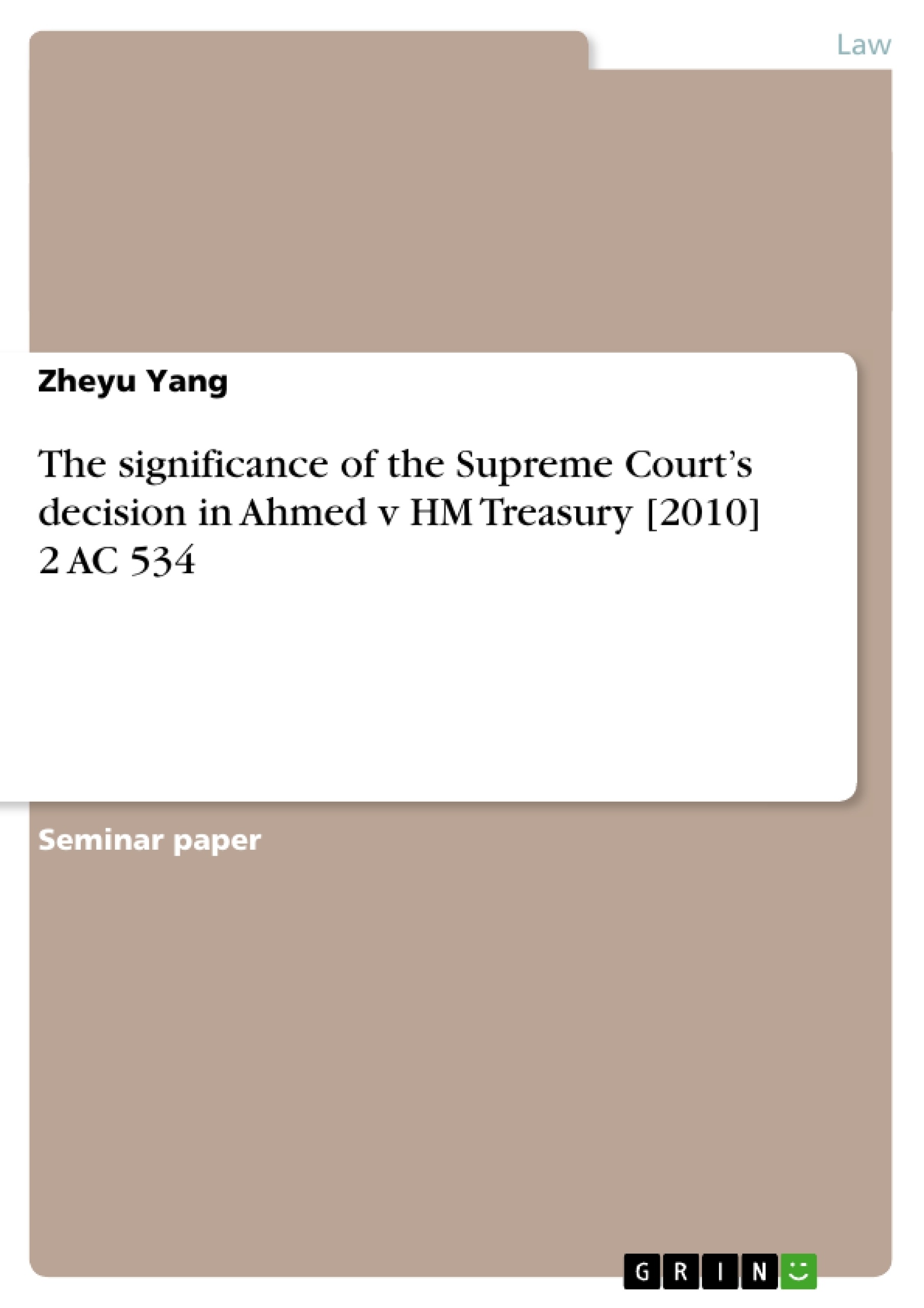This essay relates to the case of Ahmed v HM Treasury, the first case that
was heard by the newly constituted Supreme Court of the United Kingdom,
concerning with the freezing of assets of five men who were suspected of
involvement in financing terrorism. It can be conceived as the most influential
Supreme Court case to date not only because of its constitutional significance
but also because of its raising of issues relating to abuse of executive power,
personal liberty and international terrorism. The Court’s confronting issue is of
the lawfulness of the Terrorism Order 2006(‘the TO’)1 & the Al-Qaida and
Taliban Order 2006 (‘the AQO’) art. 3(1)(b)2, to be introduced by the
Treasury under the United Nations Act of 19463 with respect to fighting
terrorism by freezing the assets of suspected individuals. Further analysis will
be given through explanation over the basic facts and the Supreme Court’s
decision, then processes to clarify its significance in national and international
contexts respectively, the last section will conclude and draw summary. The
major viewpoint is that despite the court’s increasing power in prohibiting
unlimited executive power, the decision highlights a shift in power back to the
legislature as the court has no power to strike down any irreconcilable
primary legislation or secondary legislation authorised by primary legislation.
The decision also depicts the court’s aggravating effect at international level
in deciding which legal regime to apply in a single case through either
constitutionalism or pluralist logic.
Inhaltsverzeichnis (Table of Contents)
- The Fact and Decision
- The Significance at National Level
- Separation of Powers
- Parliamentary Sovereignty
- The Significance at International Level
Zielsetzung und Themenschwerpunkte (Objectives and Key Themes)
This essay examines the significance of the Supreme Court's decision in Ahmed v HM Treasury, focusing on the case's constitutional implications and its impact on the relationship between the executive, legislative, and judicial branches of government. The essay also analyzes the court's approach to reconciling conflicting international legal regimes in a single case.- The interplay between the executive, legislative, and judicial branches of government in the context of anti-terrorism measures.
- The balance between national security and individual rights, specifically the right to a fair trial and the right to due process.
- The court's role in interpreting and applying international law, particularly UN Security Council resolutions, within a national legal framework.
- The tension between constitutionalism and pluralism in reconciling different legal orders and their respective claims to authority.
- The implications of the decision for the UK's domestic and international legal landscape.
Zusammenfassung der Kapitel (Chapter Summaries)
The first section of the essay presents the facts of the Ahmed v HM Treasury case. The Orders in Council, which were made under powers conferred by the UN Act 1946, sought to give effect to UN Security Council resolutions (SCRs) on the freezing of terrorist assets. The Supreme Court quashed the orders, finding them to be ultra vires the 1946 Act. The court held that the executive had exceeded its authority by adopting the 'reasonable suspicion test', which was not supported by either the SCRs or the 1946 Act.
The second section examines the significance of the decision at the national level. The essay argues that the decision represents a reassertion of parliamentary sovereignty, highlighting the importance of Parliament's role in authorizing any encroachment on fundamental rights. The decision also emphasizes the need for judicial oversight of executive power to ensure that it does not exceed its delegated authority.
The third section discusses the international implications of the case. The decision reflects the Supreme Court's approach to reconciling different international legal regimes, including national law, EU law, ECHR law, and UN Charter law. The essay explores the tension between constitutionalism and pluralism in this context, arguing that the court adopted a pluralistic approach by considering various layers of law and ultimately prioritizing the UK's domestic constitutional values.
Schlüsselwörter (Keywords)
The key themes and concepts explored in this essay include: Ahmed v HM Treasury, Supreme Court, Terrorism Order 2006, Al-Qaida and Taliban Order 2006, UN Act 1946, UN Security Council Resolutions, Separation of Powers, Parliamentary Sovereignty, Judicial Review, Constitutionalism, Pluralism, International Law, Human Rights, Due Process.- Quote paper
- Zheyu Yang (Author), 2014, The significance of the Supreme Court’s decision in Ahmed v HM Treasury [2010] 2 AC 534, Munich, GRIN Verlag, https://www.grin.com/document/288562

![Title: The significance of the Supreme Court’s decision in Ahmed v HM Treasury [2010] 2 AC 534](https://cdn.openpublishing.com/thumbnail/products/288562/large.webp)


